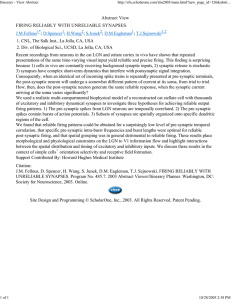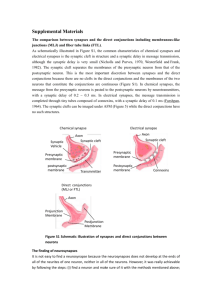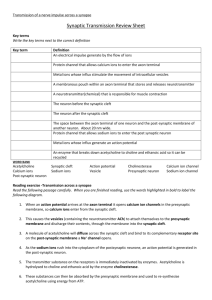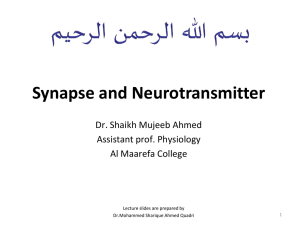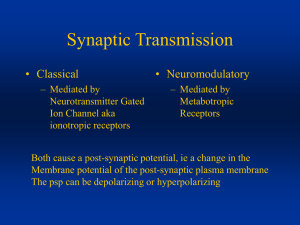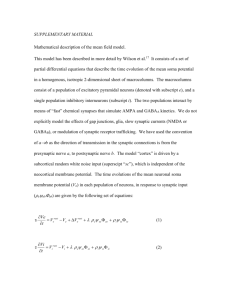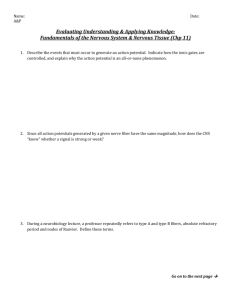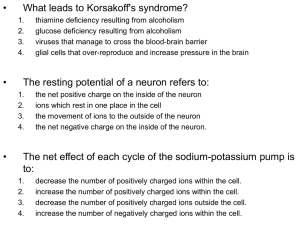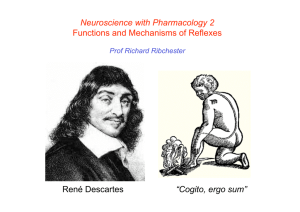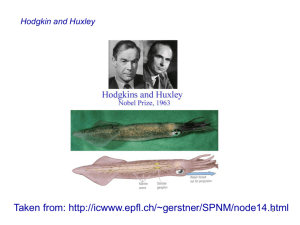1. Physiology of Synapses & Receptors
advertisement
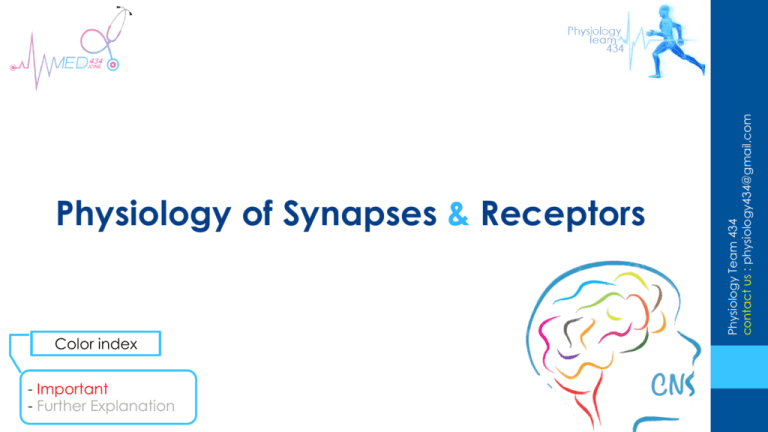
Physiology Team 434 contact us : physiology434@gmail.com Physiology of Synapses & Receptors Color index - Important - Further Explanation CN Contents ✧ ✧ ✧ ✧ ✧ ✧ ✧ ✧ ✧ ✧ ✧ ✧ ✧ ✧ Mind map.......................................................3 Introduction……………………………………..4 Type of synapses………………………………..5 Divergence & convergence………………….6 Ca VGIC…………………………………………..7 Pre-synaptic………………………………………8 Post-synaptic……………………………………..8 Fate of neurotransmitters……………………….9 Summation……………………………………….10 EPSP & IPSP……………………………………….11 LTP………………………………………………….12 Acidosis & alkalosis……………………………13-15 MCQs………………………………………………16 SAQs………………………………………………..17 Recommended Videos! 3 : 18 Very useful 10:56 Please check out this link before viewing the file to know if there are any additions/changes or corrections. The same link will be used for all of our work Physiology Edit 2 3" Mind Map Introduction New terms • Soma = cell body of neuron . • EPSP = excitatory postsynaptic potential . • IPSP = inhibitory postsynaptic potential . • GABA = gamma-aminobutyric acid (neurotransmitter). • LTP = long term potential. What is synapse ?? • It is an area of communication between two neurons. Components of synaptic 1. Synaptic knob of pre-synaptic cell. 2. Synaptic cleft . 3. Post-synaptic membrane . 4" Type of Synapses There are two major types of synapses : the chemical & the electrical synapses. and conjoint synapses (both chemical & electrical) Mostly all the synapses used for signal transmission in CNS are chemical . Neurotransmitter which is the substance that secreted from first neuron to act on the receptor in the membrane of the next neuron to excite it, inhibit it, or modify its sensitivity. Electrical synapses are characterized by pores allow ions to pass from one neuron to another called (gap junction). They are faster than chemical synapses because of gap junction 5" Divergence & Convergence DIVERGENCE CONVERGENCE A- divergence to cause amplification ()توسعه B- divergence to to multiple tract and different area multiple input fibers onto a single neuron. ( )جمع اكثر من نيرون الى نيرون واحدand it could be from one source or multiple different sources. 6" Voltage Gated Calcium Ion Channels 1 2 1) The gate close when there is decreasing in positive charge or increasing in negative charge. 2) The gate open when there is increasing in positive charge. 7" Pre-synaptic Receptors Action potential initiate the opening gated Ca channels Allow sodium ion (Na) to enter Ca ion enter the synapse and bind to the vesicle surface receptors (contain neurotransmitter) synaptotagmin The neurotransmitter will spread in synaptic cleft and bind to Ligand gated ion channel in postsynaptic Which will cause to vesicles to move towards and fuse with synaptic membrane Vesicles release their contents into the synaptic cleft Post-synaptic Action Potential Then Na travel and spread in post-synaptic cell and go to trigger zone (axon hillock) to make an action potential 8" Fate of Neurotransmitter Diffusion out of synaptic cleft into surrounding fluid Reuptake back into the pre-synaptic cleft • Dopamine does this Breakdown by enzymes • Norepinepherin • Acetylcholine Monoamine Oxiase Acetylchlinestrase. 9" Summations Temporal summation It is two EPSP but different in time. So if there a great time lag the can’t deliver an action potential Spatial summation It is two EPSP but different place. So if there a great time lag (because pre-synaptic terminal far apart) can't deliver an action potential 10" EPSP & IPSP EPSP Type IPSP Graded potential s Responses Local (unpropagted) Summation Can be summated Function Make the post-synaptic membrane excitable (by influx of Na) Make the post-synaptic membrane less excitable (by influx of Cl) Examples 1- Acetylcholine (open sodium channel) 1- GABA (open chloride and potassium channels) 2- Enkephalin (analgesic activity by reducing the pain) 3- Glycine (mainly in spinal cord) 2- Glutamate (open calcium channel) 11" Long Term Potentiating 2:35 min " This cellular mechanisms underlies learning & memory. " Along-lasting enhasment in signal transmission two neurons that resulting from stimulating them synchronously (occurring at the same time = !"#$%"). " It is phenomena underlying synaptic plasticity, the ability of chemical synapses to change their strength. Before LTP After LTP 12" Alkalosis and Neuronal Function Normally, alkalosis increases neuronal excitability (pH: 7.4 7.8). Alkalosis causes H+ to move out from the cells and K+ to move in to the cell, leading to hypokalemia. This leads to a higher concentration gradient between intracellular and extracellular K+ leading to more K+ exiting the cell through leakage channels leading to hyperpolarization of the cell. This means that a greater than normal stimulus is required to reach the threshold and thus elicit a subsequent action potential. 13" Acidosis and alkalosis Alkalosis • Increase in body pH >7.4 • Increase neural excitability. • Could cause cerebral epileptic seizure ()صراع, easy to demonstrated well by asking a person who is predisposed to epileptic seizure to over breathe Acidosis • Decrease in body pH <7.4 • Decrease neural excitability. • Cause comatose state ()غيبوبة. • Sever diabetic, uremic acidosis coma always develops. 14" Acidosis and Neural Function Acidosis depresses neuronal activity (pH: 7.4 7.0). Acidosis causes H+ to move into the cells and K+ to move out from the cell, leading to hyperkalemia. This leads to a lower concentration gradient between intracellular extracellular K+, leading to less K+ exiting the cell through leakage channels leading to relative depolarization of the cell. This means that a weaker than normal stimulus is required to reach the threshold for eliciting a subsequent action potential. For a transient period, the cells can be more easily depolarized. However, this causes some of the Na+-VGCs to activate (but their number is not enough to elicit depolarization and subsequent action potential), causing them to enter in a refractory mode. 15" This eventually leads decrease in excitability of the cell (e.g.: slowing of conduction in cardiac muscle that can lead to ventricular fibrillation or asystole).causes comatose state 5- The LTP underline to... A. Memory. B. Sleep C. Learning D. Both A & C. 2-Gap junction is found in chemical synaptic? A. True B. false 6-Acidosis cause ... A. Lead to decrease in excitatory of the cell. B. Lead to increase in excitatory of the cell. C. Cause comatose state. D. Cause cerebral epileptic seizure. E. Both A & C. F. Both B & C. 3-Temoral summation is ... A. It is two EPSP but differ in places B. It is two EPSP but differ in time C. It is two IPSP but differ in time D. It is two IPSP with the same time 4-GABA is IPSP ? A. True . B. False. MCQs 1- Soma is ... A. Synaptic cleft B. Cell body of neuron C. Hillock of axon D. Non of them 1.B 2. B 3.B 4.A 5.D 6.E 16" 1-what are the component of synaptic ? a) Pre-synaptic . b) Synaptic cleft. c) Post-synaptic 2-what is divergence ? And convergence? .divergence is one neuron divided into many branches Convergence is multiple neuron convert into one neuron 4-what are the type of summations ? .temporal and spatial 5-Give one example for EPSP & IPSP .EPSP = glutamate. IPSP =GABA. 6-what does Long-term potentiation mean ?and why it happen ? .means the respond will remain after action potential finished. It happe to change the strength of chemical synapse. SAQs 3-define synaptic ? What are their type ? .it is an area of communication between two neurons. Chemical, electrical. Conjoint. 17" THANK YOU FOR CHECKING OUR WORK! Done By: ! Abdulaziz alsaud. ! Abdullah al faleh 18"
